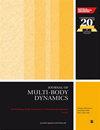A novel dynamic dry friction model for applications in mechanical dynamical systems
IF 1.9
4区 工程技术
Q3 ENGINEERING, MECHANICAL
Proceedings of the Institution of Mechanical Engineers Part K-Journal of Multi-Body Dynamics
Pub Date : 2023-04-25
DOI:10.1177/14644193231169325
引用次数: 1
Abstract
This work presents a novel continuously differentiable, dynamic dry friction model, with dependence on normal contact force, slip velocity, and static and dynamic coefficients of friction. The state-of-the-art, Brown and McPhee friction model depends on transitional velocity, which is an empirical parameter. A limitation with this model is that there is no generic approach to select the optimal value for the transitional velocity for a certain application. The simulation results presented in this work highlight the sensitivity of friction force with transitional velocity in Brown and McPhee’s model to obtain smooth solutions, which are supportive in control system applications. It is because control systems require jitter-free signals in order to save costs on low-pass filters. The proposed model overcomes such empirical dependence on transition velocity through a combination of an iterative methodology and an empirical parameterization. In this article, a comprehensive analysis of the proposed friction model and the contributing parameters is carried out. The algorithm to implement the proposed friction model is elaborated. The proposed friction model is then simulated and compared against Brown and McPhee’s model. using a stick-slip benchmark problem. Furthermore, the proposed force model is applied to two spatial multibody systems formulated using index 0 tangent space differential-algebraic equations. The results demonstrate how the proposed friction model can be employed in dynamical mechanical systems. The independence on transitional velocity in the proposed friction model is observed to be effective for obtaining smooth solutions that make it suitable for control system applications.一种用于机械动力系统的新型动态干摩擦模型
这项工作提出了一种新的连续可微的动态干摩擦模型,该模型依赖于在法向接触力、滑移速度以及静摩擦系数和动态摩擦系数。最先进的布朗和麦克菲摩擦模型依赖于过渡速度,这是一个经验参数。该模型的一个局限性是,对于特定的应用程序,没有通用的方法来选择过渡速度的最佳值。本文的仿真结果突出了Brown和McPhee模型中摩擦力随过渡速度的敏感性,从而得到光滑解,为控制系统的应用提供了支持。这是因为控制系统需要无抖动信号,以节省低通滤波器的成本。所提出的模型通过迭代方法和经验参数化的结合克服了这种对过渡速度的经验依赖。在本文中,对所提出的摩擦模型和贡献参数进行了全面分析。阐述了实现所提出的摩擦模型的算法。然后对提出的摩擦模型进行模拟,并与Brown和McPhee的模型进行比较。使用一个粘滑基准问题。此外,将所提出的力模型应用于两个由指数为0的切空间微分代数方程构成的空间多体系统。结果表明,所提出的摩擦模型可以应用于动态机械系统。观察到所提出的摩擦模型与过渡速度无关,对于获得光滑解是有效的,使其适合于控制系统应用。
本文章由计算机程序翻译,如有差异,请以英文原文为准。
求助全文
约1分钟内获得全文
求助全文
来源期刊

CiteScore
4.10
自引率
11.10%
发文量
38
审稿时长
>12 weeks
期刊介绍:
The Journal of Multi-body Dynamics is a multi-disciplinary forum covering all aspects of mechanical design and dynamic analysis of multi-body systems. It is essential reading for academic and industrial research and development departments active in the mechanical design, monitoring and dynamic analysis of multi-body systems.
 求助内容:
求助内容: 应助结果提醒方式:
应助结果提醒方式:


